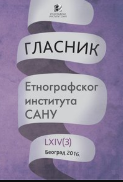Базилиск (змија-петао) и његова симболика у општем и јужнословенском контексту
Basilisk (Cockatrice) and its Symbolism in the General and South Slavic Context
Author(s): Ivana Bašić, Aleksandar UzelacSubject(s): Archaeology, Cultural history, Customs / Folklore
Published by: Етнографски институт САНУ
Keywords: basilisk; cockatrice; snake emperor; Abraxas; imaginary bestiary;
Summary/Abstract: The paper deals with the genesis of the image and the symbolism of one of the most striking figures in the imagined medieval bestiary - basilisk, and its related mythical animals - cockatrice, serpent's king, abraxas, both in the general and South Slavic context. An analysis of written sources, from antiquity to medieval and early modern epoch, the folk tradition, as well as artistic representations, show that basilisk and its related forms, emerged through joining the elements of the snake / dragon and the cock / bird. Although essentially ambivalent, they had essentially positive symbolism by representing the driving force and activity, the overcoming of opposites, the establishment of integrity, and the complexity of human nature and cosmic synthesis.
Journal: Гласник Етнографског института САНУ
- Issue Year: LXVI/2018
- Issue No: 1
- Page Range: 155-176
- Page Count: 22
- Language: Serbian

